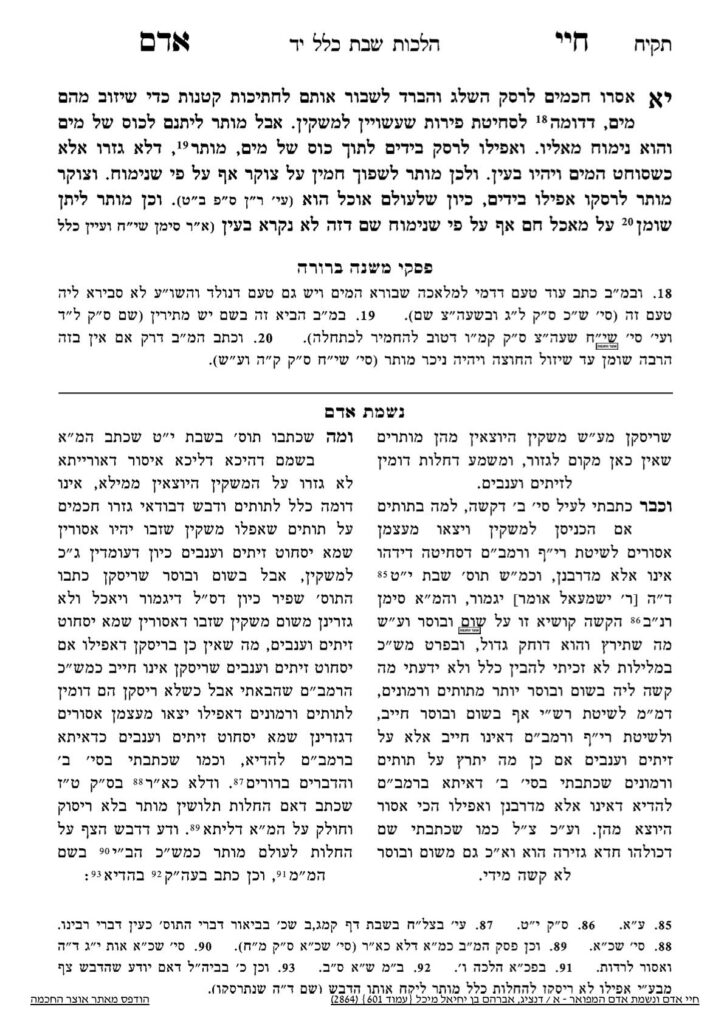We are continuing in siman 11, regarding the halachos of melting ice and snow. We learned about the concepts of nolad and muktzeh, and how that plays out in regards to melting ice and snow.
The Gemara discusses rain, and whether one can use rain which falls on Shabbos. Obviously, water is muchan in the sense that people assume they will need water over Shabbos. However, one could argue that rainwater did not exist before Shabbos, so it should have the same issue of nolad. The Gemara in Eruvin explains that rainwater is different, because it was already in the clouds from before Shabbos. Thus, it is not full nolad, since a person has in mind that whenever the clouds release their water, they will use it. Rebbi Shimon is not concerned for nolad over here, since it had already existed in some form.
Tosfos (Beiah 2a) suggests that maybe even Rebbi Shimon, who is not concerned about nolad, will agree that a nolad gamur, something which had absolutely no existence before Shabbos, will be assur. For example, a window air conditioning unit works with coils that cool the air around it. Through the process, the natural water vapor in the atmosphere will gather on the coils and drip out. This water is water vapor which condenses through the coils. Even though there is water in the atmosphere, it does not exist, as far as humans are concerned, as it is not visible or touchable . If so, if it is converted into water, many poskim assume the water is nolad gamur and muktzeh. Thus, one could not drink that water or use that water for an animal, and so on. If the water drains into a utensil, the utensil will be muktzeh as well.
Tosfos explains that according to Rebbi Shimon, nolad is not an issue in cases where the item was in existence in a different form which changed over Shabbos. Thus, according to this explanation, snow or ice which turns into water should not be an issue. Although it changed form, it was pre-existing before Shabbos, so it is not nolad gamur.
The Sefer Haterumah, who is the author of the third explanation that melting ice or snow is assur due to nolad, appears to understand that even though Rebbi Shimon is more lenient in his understanding of muktzeh and would not have a issue of muktzeh with the snow or ice, he would be concerned for nolad, even though it is not nolad gamur.
This question might parallel a different question, which is how we look at liquids which were frozen and subsequently melted. On the one hand, we could consider the liquid as remaining in its inherent state, and it remains a liquid even while it is frozen. On the other hand, we could look at the solid state of the item as an indication that it is now a food, such that when it melts, it is nolad.
This question has multiple halachic ramifications.
- It is muttar to heat up a food which is fully cooked on Shabbos, but it is assur to heat up a liquid.
- Regarding hilchos brachos, if it is considered food, the shiur for bracha achrona is a kezayis, but if it is considered a mashkeh, the shiur will be a reviis which is drunk within the timeframe for drinking a reviis.
- Additionally, we do not make brachos on drinks during the meal, but we would make a bracha on a dessert at the end of a meal. Thus, for example, if ice cream is a food, it would receive a bracha, but if it is a liquid, it would not.
- Also, if it is a liquid, if it is eaten together for another food, it would require washing one’s hands (davar shetibulo b’mashkeh).
- There is a machlokes Rebbi Yehuda and Rebbi Shimon whether one’s items are by default designated for Shabbos use, or whether they must be deliberately designated.
- Arguably, all can agree that if the item did not exist before the onset of Shabbos, it is not possible to have designated it, so it will be muktzeh. This is known as nolad.
- Tosfos argues that Rebbi Shimon will agree that nolad gamur is assur, but something which existed in a different form will be muttar. The Sefer Haterumah understands that even this lower form of nolad will be assur according to Rebbi Shimon.



